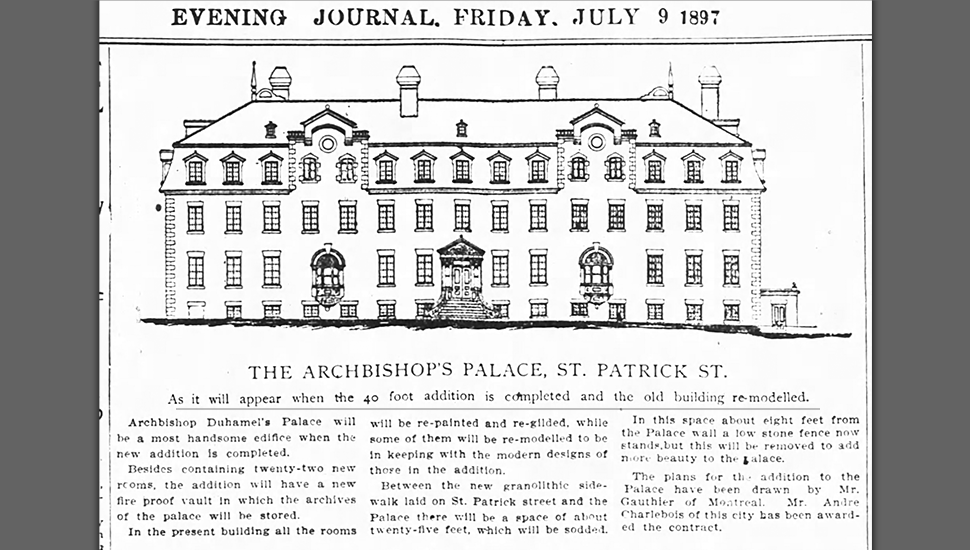31. Archbishop's Palace
Construction: 1849-1850 | Addition: 1897-1898 | Restoration: 1976-1978
Architects: Fr. Damase Dandurand | Louis Zephirin Gauthier | Edward J. Cuhaci and Associates
Location: 143 St. Patrick Street, Ottawa
The Archbishop’s Palace (known as the Bishop’s Palace until 1886) was built between 1849 and 1850 during the same period as Notre Dame Cathedral Basilica and the College of Bytown on Sussex Drive. The design is attributed to Father Damase Dandurand (1819-1921). The building remains the official residence of the Roman Catholic Archbishop of Ottawa.
A solid structure of 2 ½-storeys, the stone building features a full basement, eight symmetrical window bays and large quoins. In 1862, a two-storey link was built connecting the Palace with the adjacent Choir of Notre Dame Cathedral Basilica.
In 1897, Montreal architect Louis Zephirin Gauthier (1842-1922) designed a large east-end addition that extended the façade to 15 bays and re-modelled the exterior in a Second Empire style. Two symmetrical gables with frontispiece treatment and oriel windows (a type of bay window braced by a bracket or corbel beneath) and a new centered, ornate entrance were added to the front elevation. Internal modifications included the installation of gas and electric lighting.
Over the years there were many calls to replace the “antiquated” Archbishop’s Palace with a more modern building. A special committee of priests and laymen appointed to look at the Archbishop’s Palace reported in 1971 that the residence was in a “general state of old age” and estimated the cost of basic repairs at more than $250,000.
The Heritage Committee of the Capital for Canadians (predecessor of Heritage Ottawa) raised the alarm about the building’s imminent demolition in the fall of 1972. Finding a new use for it seemed the only solution, as Archbishop Aurèle Plourde made it clear that the building’s preservation was unaffordable:
"Nobody is bound to do the impossible, and it is impossible for the diocese to invest half a million dollars to preserve historic buildings."
Negotiations between the archdiocese and the National Capital Commission (NCC) to find a funding formula for the Palace’s rehabilitation dragged on under constant threat of demolition. In January 1973 the Heritage Committee offered to set up The Bishop’s Palace Heritage Fund to raise money, but discarded the idea when estimated costs began to escalate. By the fall of 1974, discussions had broken down.
On March 21, 1975 an agreement was signed by Urban Affairs Minister Barney Danson on behalf of the NCC and by Archbishop Plourde. The NCC agreed to buy and restore the Archbishop’s Palace. The Diocese would contribute $600,000 from the sale to the NCC of its Episcopal headquarters at 256 King Edward Avenue. In 1979, the Ontario Heritage Foundation (renamed the Ontario Heritage Trust) awarded a $106,000 grant towards the restoration.
The rehabilitation of the Archbishop’s Palace was led by Edward J. Cuhaci and Associates of Ottawa. Restoration focused on the 1897-1898 structure. On the interior, selected architectural elements were dismantled, repaired and reinstated.
In December 1981, Heritage Ottawa co-founder R.A.J. (Bob) Phillips, recalled in Ottawa Magazine:
"The … Bishop’s Palace … is the finest example of the French Empire style on this part of the planet. … A public campaign by citizens of all faiths and none, helped create the setting for an eventual agreement between the church and the NCC that involved substantial financial help for permanent preservation. Now the palace has a renewed useful life for those who work within it, and it is a lasting pleasure to those who go by."
Today, the historical, architectural, aesthetic and scenic character and condition of the property and building exterior are protected by an Ontario Heritage Trust conservation easement. The building is also designated by the City of Ottawa under Part IV of the Ontario Heritage Act (By-law 353-78).
The building at 143 St. Patrick Street is currently the residence of the ninth Archbishop of Ottawa, Terrence Prendergast. The Archdiocese offices have been transferred to 1247 Kilborn Place in Alta Vista.
It was surprising to many that despite the long history and associative value of the building to the Archdiocese, the local Roman Catholic community and Notre Dame Cathedral Basilica, the Diocese never acknowledged the heritage significance of the Archbishop’s Palace.





